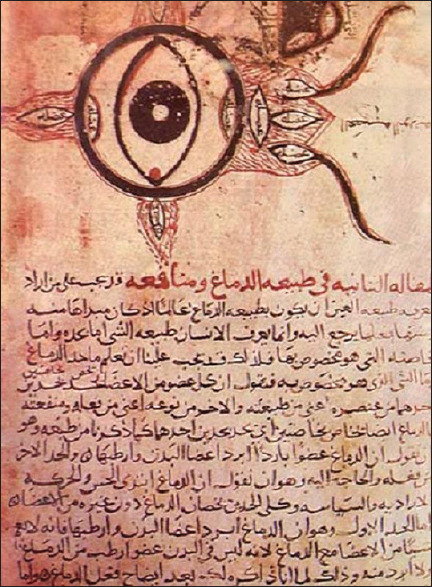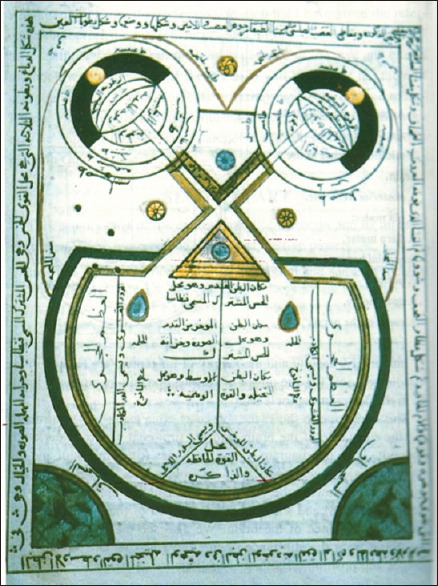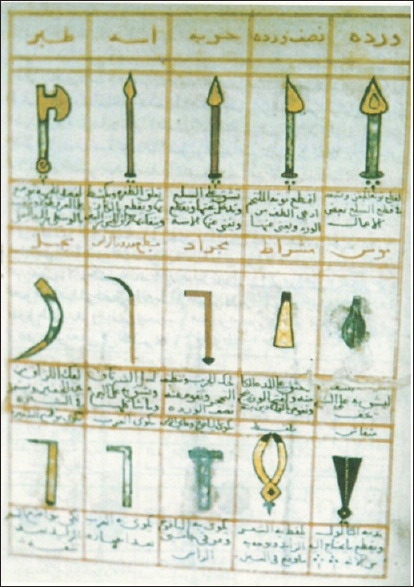Abstract
Arab and Muslim scientists were pioneers in the development of medical sciences, treating patients, and performing operations in many medical specialties. This article reviews their major contributions in ophthalmology that led to the development of this field. Considering the little-known role of Arab and Muslim scientists in the history of ophthalmology, this article provide insights into the great physicians from the 10th to the 13th century. Despite the destruction of Islamic civilizations by the Mongols in the late 14th century, some of their books and manuscripts are still preserved, testifying to their influence, including the first detailed drawing of the eye anatomy by Hunayn AlAbadi (808 A.D.), proposing the first occlusive treatment for amblyopia by Thabit Alharrani (823 A.D.), discovering the science of optics and theory of vision related to light reflection by Al-Hasan ibn Al-Haytham (965 A.D.), inventing of the hollow needle used to aspirate cataract by Ammar Al-Mawsili (1010 A.D.), and drawing surgical instruments by Khalifah ibn Al-Mahasin (1256 A.D.).
Keywords: History, Ophthalmology, Muslim, Arab, Contribution
INTRODUCTION
This article reviews the major contributions of Arab and Muslim scientists/ophthalmologists from the 10th to the 13th century A.D. The Arabs based their principles of ophthalmology on Greek material but added their contributions.[1] An eye surgeon was referred to as “Al-Kahhal” in Arabic, meaning an individual who applies “Kuhl,” eye powder.[1] Muslim eye surgeons used to operate, dissect, discover, and write their findings in textbooks.[2] They made a valuable contribution to the anatomy of the eye, although their studies were limited to animal eyes because dissection of the human body was considered disrespectful. Their work produced the oldest pictures of the anatomy of the eye.[3]
More manuscripts were written in Arabic between the years 800 and 1400 than in the Greek, Latin, and European languages. There were 36 libraries in Bagdad before its destruction by the Mongols.[4] In the 12th century, Spain had 70 libraries, while the rest of Europe had none.[5] Arab hospitals had eye wards, in which they used soporific drugs such as opium during painful eye operations.[4] According to Professor Hirschberg, a 20th-century German professor of medicine, the Arabs wrote 30 textbooks of ophthalmology between 870 and 1370 A.D., of which 14 were preserved, 10 were written in Arabic, and 10 were written by ophthalmologists; some of these textbooks are discussed in this review article.[1,5]
The greatest Muslim contribution was in cataract treatment.[2] Arabs called cataract “al-ma',” meaning water or “al-ma' an-nazil fi ala'in” the water descending to the eye, which is used daily.[1] They also introduced other common terms such as the conjunctiva, cornea, uvea, and retina.[3]
ARAB AND MUSLIM SCIENTISTS AND THEIR MAJOR CONTRIBUTIONS
Hunayn ibn Ishaq Al-Abadi (808-873 A.D.)
Author of Ten Treatises on the Eye or 
Al-Abadi was a scientist from Bagdad, Iraq. He wrote the first Arabic scholarly systemic textbook related to ophthalmology, which included the first known drawing of the eye, optic nerve, and the six muscles. The book was translated into Latin and English [Figure 1].[1,6,7] In addition to his knowledge and skills as a physician and ophthalmologist, he was the chief translator of books on medicine, botany, and mathematics. His native language was Syriac, and he also was proficient in Arabic, Persian, and Greek.[6,8]
Figure 1.

The Anatomy of The Eye by Hunayn Ibn Ishaq. A 12th century manuscript copy of the original 9th century manuscript, from the book “Ten Treatises on the Eye” drawn by Hunayn Ibn Ishaq Al-Abadi (808– 873 A.D.)
Thabit ibn Qurrah Alharrani (823–900 A.D.)
Author of Vision and Perception or 
Thabit described the first occlusive treatment found in the literature for the treatment of lazy eye or amblyopia. He suggested closure of the normal eye with a patch to strengthen the lazy eye by forcing the “visual spirit” to go into the lazy eye: This was a leading breakthrough in ophthalmology.[5,6]
Abu Bakr Mohammad ibn Zakariya Al-Razi (850–923 A.D.)
Author of Continens or 
Al-Razi was one of the most respected physicians of all time. He wrote 113 textbooks on general medicine; the most popular was Continens, which comprised 20 volumes. The second volume discusses diseases of the eye. It is considered a valuable source of lost Greek writings.[4,6] He rejected Galen's theory of vision, in which “a ray exits the eye to touch the object or objects in front of it and then return to the eye where the vision takes place.” Al-Razi's theory was that rays are released by the object and enter the eye.[6] He described the effect of illumination on the pupil, which had not been mentioned in Greek books: “The membrane of the iris contains in its center a hole, which now dilates, now contracts, according to the quantity of light required by the crystalline: it contracts, if the illumination is bright, it dilate in the dark.”[1,8] He recommended anesthetics for severe pain and a mercurial ointment for lice of the eyelids.[4] He advised everting the upper lid to search for trachoma in cases of persistent conjunctivitis.[1]
Ali ibn Isa Al-Kahhal (940–1010 A.D.)
Author of notebook of the oculist or 
Al-Kahhal was a scientist from Bagdad, Iraq; his textbook is the oldest and most complete ophthalmology textbook fully preserved and in its original language; was translated into English, German, and Latin; survived for 800 years; was the most widely referenced textbook in Europe; and is worthy of being called the Arabian canon of ophthalmology.[1,2,3,4,6] The book covers over 130 eye conditions divided into three books: the first focused on anatomy and physiology, the second on perceptible eye disease, and the third on hidden eye diseases. He also noted that diseases of the eye were a sign of other associated conditions.[1,2] He was the first scientist to describe Vogt–Koyanagi–Harada syndrome.[9] At the end of his book, he listed 143 medications and their effects on the eye in alphabetical order.[8] Ali had a great sense of humanity, and during cataract operations, he said, “When the cataract needle has entered the interior of the eyeball, then address the patient with kind words to quiet the fears.”[1]
Al-Hasan ibn Al-Haytham (Alhazen) (965–1039 A.D.)
Author of Book of Optics or 
A scientist from Basra, Iraq, is known as “The Father of Experimental Science” or “The Father of Modern Optics.” He wrote approximately 90 books, and his main book was Almanazir, also known as “Optic treasure,” which was translated into western languages.[10] Ibn Al-Haytham started his book with a detailed description of the anatomy of the eye and the nature and structure of each part: the cornea, lens, iris, and aqueous humor.[10,11] Ibn Al-Haytham was a respected genius of his time and created the famous “Camera Obscure or the Pinhole Camera,” considered the basis of photography and optics.[5,12] He studied his observations in a dark chamber called in Arabic “albayt almuzlim” translated to “Camera Obscura” in Latin. He observed the light emanating from a pinhole in the wall in straight lines and reflecting on an image on the opposite wall, from which he concluded that vision is a result of rays emitted from external sources and enter the eye, instead of rays released from the eye itself – as was believed.[12,13]
The earliest concept of the visual pathway was proposed by Ibn Al-Haytham, in which he mentioned that different points in the retina sensitize different parts of the visual spirit confined to different filaments that travel to the brain. He stated that no visual sensation is established until the image arrives in the brain.[12] He explained that a single image can be seen if an object falls on the same corresponding point, and two images are seen if they fall on noncorresponding points. This principle is the same principle as binocular vision.[6,12] He also stated that both eyes always move together by an equal amount; he wrote, “When one eye moves for the purpose of vision, the other eye moves for the same purpose and with the same motion; and when one of them comes to rest, the other is at rest,” which is now referred to as Hering's Law of Equal Innervation.[12]
Another major contribution of Ibn Al-Haytham was the theory of light reflection in spherical mirrors; he identified five types of mirrors (plain, conical, convex, circle, and concave). He calculated for the first time the location of a focal point and the longitudinal distortion of a concave mirror, and he stated that vision is caused by reflection.[1,6] Moreover, he appreciated the magnification of images through colorless surfaces, but he could not find, at that time, any application for this observation until it was used later in the invention of lenses.[14] He also described optical illusion, and it is believed that he was the first scientist who did so.[6] Ibn Al-Haytham made a strong impact on the next five centuries in Europe; his remarkable efforts opened the path to the science of optics in all nations.[11]
Abu Al-Hasan Ahmad ibn Mohammad Al-Tabari (976 A.D.)
Author of The Hippocratic Treatment or 
A scientist from northern Persia, Al-Tabari, wrote a book describing the management of many eye diseases, including congenital strabismus. He advised to wrap a baby's head with black cloth with two openings in front of the eyes and stated: “There is a true congenital type of squint which is not curable because it represented an organic disease, which originates in the womb and is hereditary.”[6] He also advised people not to look at the eclipsed sun to protect the eyes from permanent blindness.[6] He described snow blindness and “seekers of the eye,” which are parasites that invade the pupils.[4] He also declared that “No treatment can be successful” for blackwater, now known as glaucoma.[6]
Ammar ibn Ali Al-Mawsili (1010–1075 A.D.)
Author of Book of Choices in the Treatment of Eye Diseases or 
A scientist from Mosul, Iraq, authored a book in which no other author, Arab or Greek, was quoted. His manuscript is in the Escorial Library in Madrid, Spain. A German version of his book was produced in 1905 by Professor Hirschberg, who called him “The cleverest eye surgeon of the whole Arabian Literature.”[1,2]
He is the inventor of the hollow needle “Almuqdah AlMujawaf” used in the aspiration of a soft cataract. This pivotal innovation in the management of cataracts is still used today – with new techniques but based on the same principles.[2,5,6] This allowed him to remove the cataract instead of pushing it away from the pupil to the back into the posterior chamber, called “couching.” He also warned other surgeons to prevent dislocating the cataract into the anterior chamber and to avoid corneal edema caused by touching the corneal endothelium, currently called corneal decompensation.[4,6]
He described the characteristics of a good surgeon in two of his most respected statements; “able, experienced, sharp-sighted and steady-handed” and “he who has no experience has no profession.”[5]
Abu Ruh Mohammad Alyamani (1088 A.D.)
Author of The Light of the Eyes or 
Alyamani was called “Gold hand” or “Zarrin Dast” because of his excellent surgical skills.[4,5] Three methods of cataract management were described in his book: couching, couching after a previous opening with a scalpel, and suction. A notable description of cataract surgery was that “a hard cataract is easier for couching, a soft cataract is difficult for couching but appropriate for suction.”[1]
Mohammad ibn Qassum Al-Ghafiqi (1165 A.D.)
Author of Guide to Ophthalmology or 
Al-Ghafiqi was a scientist from Spain. In his book, he explained the anatomy and physiology of the eye and the effect of stress on a patient's eye. He drew many illustrations of refractive errors of the eye in a chapter called “Diseases of the Visual Spirit.” Moreover, he listed more than 500 medications and 59 personal prescriptions that he prescribed for his patients. There is also a chapter on wine and alcohol, but he used no medications prohibited in Islam.[6]
Ala Al-Din Abu Al-Hasan Ali ibn Abi-Hazm Al-Qarashi (Ibn Al-Nafis) (1210–1288 A.D.)
Author of The Refined Book on Ophthalmology or 
A scientist from Damascus, Syria, Ibn Al-Nafis made several important contributions to medicine. He is credited with the discovery and explanation of pulmonary circulation.[15] In addition, he contributed to ophthalmology. Ibn Al-Nafis was probably the first to explain the difference between corneal laceration and abrasion, and the pupillary reaction during an acute attack of glaucoma. In addition, to avoid contamination, he refused to perform cataract surgery on both eyes at the same time.[6]
Khalifah ibn Al-Mahasin (1256 A.D.)
Author of The Sufficient Knowledge in Ophthalmology or 
A scientist from Aleppo, Syria, Al-Mahasin finished his book in the middle of the 13th century. It was regarded as a complete review of all previous books.[6] This book is the earliest to contain an original and very detailed drawing of the eyes and the optic chiasm Figure 2 .[5,6,16] In addition, he is the first surgeon to draw 36 surgical instruments used in eye surgeries in organized tables, with a description of each usage in a labeled box Figure 3 .[5,6,16,17]
Figure 2.

The Optic Chiasm by Khalifah Ibn Al-Mahasin. The Optic Chiasm from the book “The sufficient Knowledge in Ophthalmology” drawn by Khalifah Ibn Al-Mahasin (1256 AD), representing the eyes, the optic chiasm, the olfactory nerves, the cerebral ventricles, the pericranium, the dura mater, and pia mater
Figure 3.

Surgical Instruments by Khalifah Ibn Al-Mahasin. A page from the surgical instruments with a name and a description of each one usage, from the book “The sufficient Knowledge in Ophthalmology” drawn by Khalifah Ibn Al-Mahasin (1256 AD)
Sadaqah Al-Shazhili (1370 A.D)
Author of Ophthalmic Support for Diseases of the Visual Organ or 
Al-Shazhili was a scientist from Egypt. He was the author of the last ophthalmology textbook of the late 14th century when the Mongolian invasion was responsible for the end of the Islamic Golden Age in Bagdad.[1,5]
CONCLUSION
Muslim and Arab scientists have been pioneers in the prevention of blindness since the 10th century. Professor Julius Hirschberg (1843–1925), a German ophthalmologist and medical historian who spent 5 years studying and translating the work of Muslim ophthalmologists, wrote in his book (History of Ophthalmology): “During the total darkness in medieval Europe, they (the Muslims) lighted and fed the lamps of our science (ophthalmology) from the Guadalquivir (in Spain) to the Nile (in Egypt) and to the river Oxus (in Russia). They were the only masters of ophthalmology in medieval Europe.”[5]
Finally, we conclude that Muslim physicians of the 10th–13th century were hundreds of years ahead of their time and instrumental in great innovations in the field of ophthalmology and other medical sciences.
Financial support and sponsorship
Nil.
Conflicts of interest
There are no conflicts of interest.
REFERENCES
- 1.Hirschberg J. Arabian ophthalmology. JAMA. 1905;45:1127–31. [Google Scholar]
- 2.Al-Hassani ST. Muslim Hertiage in Our World. 2nd ed. United Kingdom: Foundation for Science, Technology and Civilisation; 2007. 1001 Inventions; pp. 174–7. [Google Scholar]
- 3.Shaikh I Muslim Hertiage. Eye Specialists in Islamic Cultures, Foundation for Science, Technology and Civilisation. [Last accessed on 2018 May 15]. Available from: http://muslimheritage.com/article/eye-specialists-islamic-cultures .
- 4.Sobotka H. Ophthalmology during the middle ages. AMA Arch Ophthalmol. 1957;57:366–75. doi: 10.1001/archopht.1957.00930050378008. [DOI] [PubMed] [Google Scholar]
- 5.published by J. P. Wayenborgh Verlag, Germany; 1985. Translated into English by Frederick C. Blodi. [Google Scholar]
- 6.Wafai Z Ophthalmologists of the Medieval Islamic World. International Congress on History of Medicine in Muslim Heritage. ???: Fez, Morocco. 2016. [Last accessed on 2018 May 20]. Available from: https://muslimheritage.com/ophthalmologists/
- 7.The Anatomy of the Eye, 12th Century Copy of a 9th Century Manuscript, Science Museum, Science & Society Picture Library. [Last accessed 2018 May 02]. Available from: https://www.scienceandsociety.co.uk/results.asp?image=10288875&itemw=4&itemf=0001&itemstep=1&itemx=1 .
- 8.Pollock WBI. Arabian ophthalmology. Br J Ophthalmol. 1946;30:445–56. [PubMed] [Google Scholar]
- 9.Schachat A, Wilkinson C, Hinton D, Sadda S, Wiedemann P. 6th ed. Elsevier; 2017. Ryan's Retina; p. 1505. [Google Scholar]
- 10.Unal N, Elcioglu O. Anatomy of the eye from the view of ibn al-haitham (965-1039).The founder of modern optics. Saudi Med J. 2009;30:323–8. [PubMed] [Google Scholar]
- 11.Masic I. Ibn Al-haitham – Father of optics and describer of vision theory. Med Arh. 2008;62:183–8. [PubMed] [Google Scholar]
- 12.Howard IP. Alhazen's neglected discoveries of visual phenomena. Perception. 1996;25:1203–17. doi: 10.1068/p251203. [DOI] [PubMed] [Google Scholar]
- 13.1001 Inventions and the World of Ibn Al-Haytham, 1001 Inventions and King Abdulaziz Center for World Culture. [Last accessed on 2018 May 20]. Available from: http://www.ibnalhaytham.com .
- 14.Gari L. The Invention of Spectacles Between the East and the West, Foundation for Science, Technology and Civilisation. [Last accessed on 2018 May 15]. Available from: http://muslimheritage.com/article/invention-spectacles-between-east-and-west .
- 15.Abdel-Halim RE. Contributions of Ibn al-Nafis to the Progress of Medicine and Urology, Foundation for Science, Technology and Civilisation. [Last accessed on 2018 Sep 24]. Available from: http://www.muslimheritage.com/article/contributions-of-ibn-al-nafis .
- 16.Al-Mahasin KI. Al-Kafi fi Al-Kuhled: Islamic Educational. ???: Scientific and Cultural Organization (ISESCO) 1990;64:326–7. [Google Scholar]
- 17.Tsoucalas G, Karamanou M, Koutsilieris M, Nikolopoulos T, Laios K, Androutsos G. The arabo-islamic contribution to the development of surgical instruments. Arch Balk Med Union. 2016;51:95–7. [Google Scholar]


